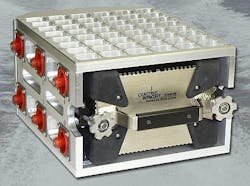Rugged solid-state drive memory for avionics and military uses introduced by Curtiss-Wright
ASHBURN, Va., 20 June 2012. Curtiss-Wright Controls Defense Solutions in Ashburn, Va., is introducing a rugged solid-state drive memory variant of the company's SANbric rugged fiber channel storage & shock isolation system for demanding military embedded systems and law-enforcement applications.
The rugged data storage device offers a solid-state-memory alternative to the rugged high capacity storage subsystem's original rugged fibre channel rotating disk storage media, and offers increased reliability compared to rotating disk alternatives, Curtiss-Wright officials say (story continues below).
In addition, the solid-state drive version of SANbric, which supports as much as 4.8 terabytes of solid state memory, reduces overall system weight as much as five pounds compared to rotating disk-based configurations.
SANbric today is deployed on widebody aircraft and several helicopters for a variety of intelligence, surveillance, and reconnaissance (ISR) applications that require high-speed, streaming data recording in harsh environments, company officials say.
The solid-state memory variant of SANbric supports as many as six solid-state drives, and mounts in a shock-isolated or lab rack-mount chassis. Shock isolation isolates the SANbric from shock and vibration.
Post-mission, after data is acquired, the SANbric can be removed and taken to the laboratory for processing and analysis. A lab rack mount chassis enables several SANbrics to be mounted easily and the data played back for analysis, company officials say.
For more information contact Curtiss-Wright Defense Solutions online at www.cwcdefense.com.
Follow Military & Aerospace Electronics and Avionics Intelligence news updates on Twitter
